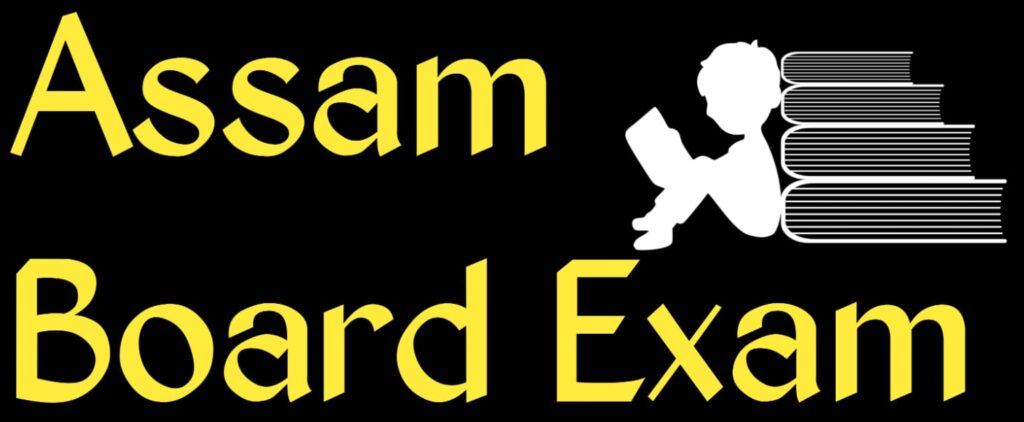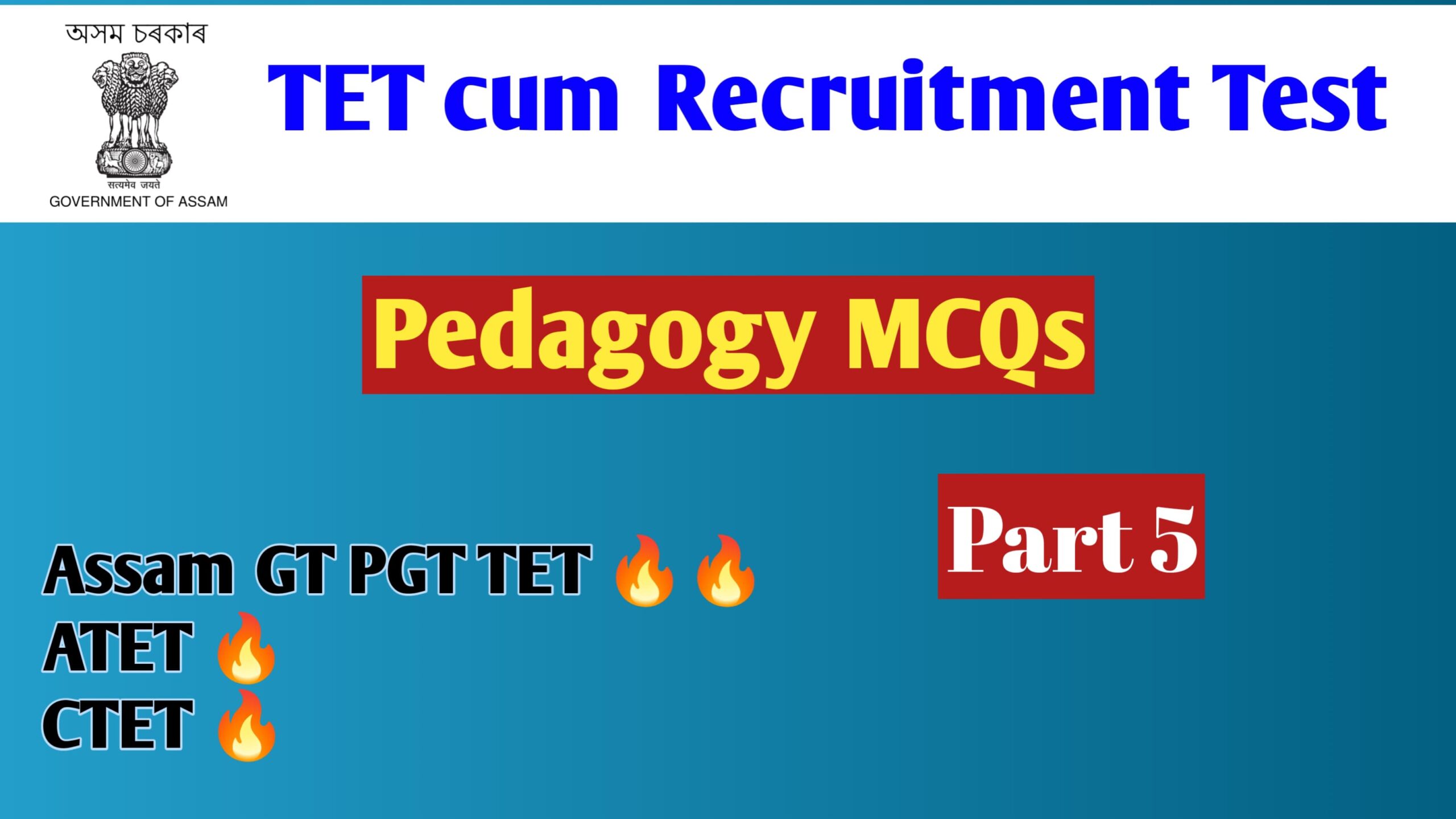Welcome to the Pedagogy MCQs section for Assam TET, GT, and PGT TET, CTET exams. This page is designed to help aspiring teachers enhance their understanding of teaching methodologies, educational psychology, and classroom management through practice questions. Pedagogy is a vital subject for any teaching exam, and practicing MCQs will strengthen your preparation.
Instructions:
- Each question has four options. Choose the correct one.
- You can use these MCQs for practice, revision, or to gain a deeper understanding of Pedagogy.
Pedagogy MCQ Questions:
26) Teaching learning materials should be selected according to
(1) their availability in respective areas
(2) the objectives of teaching
(3) their cost
(4) None of the above
Ans 2
27) Teaching learning materials make an English lesson interesting for learners if
(1) it is according to their age and level of understanding
(2) only costly materials are used
(3) they are in their mother tongue
(4) used very regularly in the learning process
Ans 1
28) One of the following quality is not expected of a good teacher
(1) communicating freely with students
(2) teaching without using any audio-visual aids
(3) acquiring knowledge about student’s background
(4) sharing warmth, enthusiasm and caring
Ans 2
29) Which of the following is not a study skill?
(1) Getting information from an encyclopaedia
(2) Writing formal reports
(3) Note taking
(4) Using a dictionary
Ans 3
30) A good language textbook should include
(1) interesting stories
(2) attractive fonts, illustrations and learner-friendly
(3) extracts from British and American literature
(4) more grammar exercises
Ans 2
31) The evaluation process in learning is
(1) quantitative
(2) qualitative and quantitative
(3) qualitative
(4) descriptive
Ans 2
32) Dyslexia is an intellectual disability that negatively affects the understanding abilities in terms of
(1) oral language
(2) sign language
(3) dialect
(4) reading
Ans 3
33) Which of the following is the highest level of cognitive ability?
(1) Knowing
(2) Understanding
(3) Evaluating
(4) Analysing
Ans 4
34) Evaluation of listening skills can not be done through
(1) ability to understand the vocabulary
(2) ability to recognise English speech sounds
(3) ability to read the text aloud
(4) ability to draw meaning from what he/she hears
Ans 3
35) While reading, a learner needs to
(1) guess the contextual meaning of new words to understand the text
(2) translate the written symbols into corresponding sounds to grasp their meaning
(3) perceive and decode letters in order to read words
(4) understand every word to grasp the meaning of the text
Ans 3
36) Under which activity do recognising sounds and deducing meanings from them come?
(1) Speaking
(2) Listening
(3) Reading
(4) Writing
Ans 2
37) Silent reading involves
(1) increase of vocabulary
(2) correct pronunciation
(3) learn to absorb or infer the underlying meaning of the text
(4) increases reading speed
Ans 3
38) Writing is the ………… representation of speech sounds.
(1) alphabetical
(2) systematic
(3) phonetic
(4) graphical
Ans 4
39) Critical thinking will be a by product of
(1) creative writing
(2) extensive reading
(3) listening carefully to others
(4) All of the above
Ans 2
40) Language skills are best learnt
(1) only through written tests and assignments
(2) if they are taught in an integrated manner as
(3) with the help of challenging and timechanical language drills
(4) when they are introduced in ents isolation, one skill at a time
Ans 2
41) When learners have diverse linguistic backgrounds, the teacher should
(1) ascertain their learning styles
(2) form groups in accordance with their linguistic backgrounds
(3) use multilingual approach
(4) start the class with brainstorming sessions
Ans 4
42) Which of the following purposes is served by a lesson plan?
(a) Suitable learning environment can be created in the class
(b) Psychological teaching is possible
(c) A teacher can stick to his content
(d) All of the above
Ans d
43) Home work:
(a) motivates pupils for further learning
(a) develops study habits
(c) reduces the burden of reteaching
(d) All of the above
Ans d
44) Lesson planning is based on the idea of:
(a) Gestalt psychology
(c) classical conditioning
(b) transfer of training
(d) None of the above
Ans a
45) A learning disabled child is one who:
(a) achieves low in one or more areas
(b) achieves low even if he is normal in intelligence (c) achieves low even if he is normal in his emotions
(d) All of the above
Ans 4
46) A child has specific learning disability if:
(a) he is unable to organize the subject matter
(b) he is unable to do correctly pronounced reading
(c) Both of these
(d) None of these
Ans c
47) Which one is not the principle of teaching English?
(1) Learning by doing
(2) Reading books
(3) Seeing the objects in real
(4) Creating interest
Ans 3
48) Which of the following is not a characteristic of a language?
(1) A vital part of growth process
(2) Has its own set of grammatical rules
(3) It is productive and creative
(4) It is spontaneous, not a result of evolution
Ans 4
49) Which of the following statement(s) is/are correct?
A. Language is one of the most important and characteristic forms of human behaviour.
B. Language helps in uniting thoughts and identity of the individual.
C. In India, linguistic diversity poses complex challenges.
D. In India, linguistic diversity provides a range of opportunities.
(1) Only A
(2) B and C
(3) Only D
(4) None of these
Ans 4
50) Before coming to school children are
(1) fully aware of all grammatical rules related to language
(2) do not know any thing about the second language
(3) well equipped in their native language to understand and explain
(4) well versed in more than one languages
Ans 3
51) In learning, a new language
(1) the knowledge of mother tongue is helpful
(2) the use of mother tongue interferes rather than facilitates
(3) the mother tongue should not be used at all by the learners
(4) None of the above
Ans 1
52) Which of the following statement is/are not correct?
(1) Language helps in uniting thoughts and identities of the individual
(2) In Indian language, diversity poses a complex problem
(3) Language is one of the most important form of communication among humans-ene svin
(4) In India, English language is spoken by 80% of population
Ans 4
53) Which is the most effective teaching method in a language class?
(1) Laying too much emphasis on correct pronunciation
(2) Reading out letters and essays from a book
(3) Emphasis on reading with correct intonation and speed
(4) Discussing a topic or idea of learner’s interest using simple vocabulary
Ans 4
54) In an English class, mother tongue influence can be effectively minimised by
(1) using the mother tongue more often
(2) giving examples from the mother tongue
(3) giving a lot of exposure to the target language
(4) giving inputs from the target language in a simple graded manner
Ans 4
55) Micro-teaching is a technique used by teacher-educators when trainees
(1) watch a live demonstration
(2) watch an audio-visual presentation
(3) received individualised, programmed instruction u
(4) use the simulation technique to develop their skills
Ans 4
56) Which of the following statements is correct?
(1) Learning is an unconscious process
(2) Acquisition is a conscious process
(3) Group activity helps in transfer of information
(4) Inputs from the target language in a complex graded manner can help in minimising the influence of mother tongue
Ans 3
57) Remedial teaching refers to teaching
(1) to help bright learners to excel
(2) to test learners periodically
(3) to address gaps in learning
(4) after the regular school hours
Ans 4
58) The language which is learnt from environment without any explicit teaching is
1)First language Implicit
(2) Second language
(3) Third language
(4) School language
Ans 1
59) Reading picture book means
(1) exposing learners to different styles of drawing.
(2) to help learners to understand and analyse the pictures.
(3) to help learners to draw neat and colourful pictures.
(4) that children love pictures and it will be a fun loving class.
Ans 2
60) Demonstration in the class helps the teacher:
(a) to understand principles or concepts
(b) to clarify the steps involved in an activity
(c) Both of these
(d) None of these
Ans c
More MCQs:
- Assam General Knowledge MCQ
- Indian History MCQ
Stay Updated
For the latest on Assam Pedagogy and other study resources, keep visiting Assam Board Exam
For More details check our Youtube Channel Assam Board Exam


